Speaking Spätzle: What to Know About this Quintessential Swabian Favorite—and How to Make It
Plump and misshapen, with a soft, chewy texture that’s reminiscent of pasta or gnocchi, Spätzle belongs in its own culinary category altogether.
Pervasive in Germany, Austria, and Hungary, and stretching into Switzerland and other neighboring European countries, the popular pasta comes in several varieties. But the miniature dumplings usually share a few common threads – a simple dough, heavy with egg and flour, and a cooking method that involves dangling the dough over simmering water so that it cooks on contact.
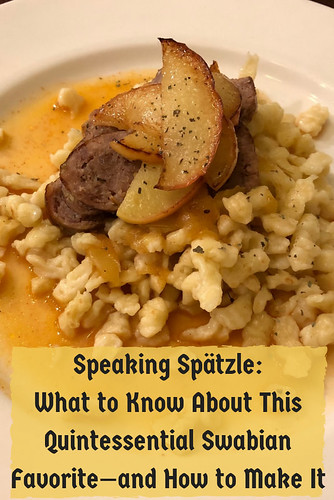
A Little Spätzle History
The exact origins of Spätzle are unknown, but it’s thought that their creation goes back to medieval times. Culinary enthusiasts like to point out the the dumpling has even inspired poets to pen prose in praise of the pasta. The Kitchen Project notes, “Josef Eberle a poet and writer of the region called Spaetzle ‘…The Foundation of our cuisine … the glory of our country, … the alpha and omega of Swabian cuisine.’”
Swabia, a region in the southwest portion of Germany, land of the Black Forest and rolling hills and mountains covered in pine, elm, oak, and beech trees, claims Spätzle as one of their specialties. And it’s from Swabia that spätzle draws its name, as spätzle appears to be a shortened from of a Swabian word for “sparrow.”

For a complete history of the pasta, The Spätzle Museum in the region offers visitors various displays and interactive exhibits exploring the humble dumpling.
Spätzle for Beginners
Spätzle comes in a variety of shapes and lengths. For traditionalists, the Spätzle dough is spread over a moistened board. Then, using a blade, pieces of the dough are expertly cut and scraped into simmering water to cook for a few minutes until puffed and then, using a slotted spoon, they’re drained. Spätzle pros can turn out the long, thin variety of the pasta quickly and masterfully. But it takes quite a bit of practice.
My preference, for both the texture and the technique is the stubbier Knöpfle. Loosely translated into “small buttons,” the stiff dough is placed into a metal “basket” that moves back and forth over a slotted plate that adheres to the cooking pot. The dough rolls with the basket, being forced in small pillows into the water below. The airy nuggets come to the water surface, where you can fish them out with a slotted spoon.
Tradition – and Fusion
While Spätzle can be served plainly, it’s often paired with stew or another sauce-rich recipe. That’s for good reason – all the ridges and crevices in the dumplings soak up sauce. The egg-rich batter just begs for a sauce.
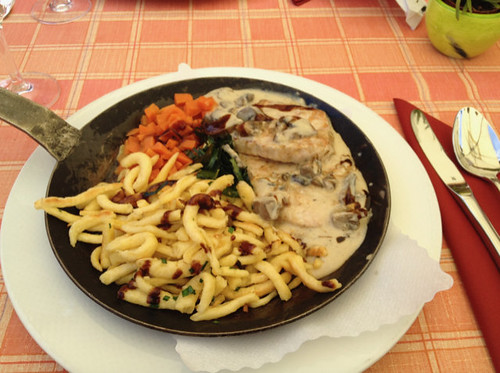
In Austria and Hungary, it seemed that Spätzle often accompanied Chicken Paprikash. From French bistros to modern gastropubs, I’ve noticed Spätzle popping up on the menu – again, I suspect it’s the novelty of the pasta’s shape and its ability to bathe in any sauce you use to go along with it.

For the fall, I created my own Spätzle recipe, using a few unusual ingredients and techniques for a new twist on this very ancient noodle. Use this recipe as a base to create your own unique Spätzle dish.
Instant Pot Honeycrisp Apples & Spätzle with Sausage
Serves: 4
Ingredients
One 19-ounce package uncooked sausage links (sweet Italian is fine, but you might look for sage or other variety); alternatively, used cooked sausages and crisp them
1 Honeycrisp apple
1 1/2 cups chicken broth
1 tsp. apple cider vinegar
1 clove garlic, minced
½ tsp. paprika
Salt and pepper to taste
Olive or grapeseed oil
Fresh parsley (optional)
Dijon mustard (optional)
1 Tbsp. butter
For the batter:
3 cups flour
1 teaspoon salt
1 cup milk
3 eggs
¼ teaspoon nutmeg (optional)
Directions
Place the sausages into an Instant Pot and pour over the chicken broth. Cut the apple into four large wedges. Place three of the wedges into the Instant Pot and reserve the other.
Set the Instant Pot on manual for 15 minutes.
Meanwhile, fill a medium-sized pasta pan with water (check that your Spätzle maker fits comfortably on the top of the pan before choosing it). Turn the stovetop on to medium-high heat so that the water comes to a gentle boil.
Mix the eggs until well blended, then add milk, then your dry ingredients (note: I try to have the eggs and milk at room temperature for easier mixing). The dough batter will be sticky. Place the Spätzle maker onto the pan and over the boiling water. Fill the Spätzle basket halfway with dough. Slid the basket back and forth over the water so that the dough drops into the water. Once all the dough is out of the basket, remove the Spätzle maker. Using a slotted spoon, skim the pasta from the top of the water and place into a strainer. Repeat with the remaining dough. You’ll probably have about three batches. Toss in a little butter, and keep warm until you’re ready to serve.
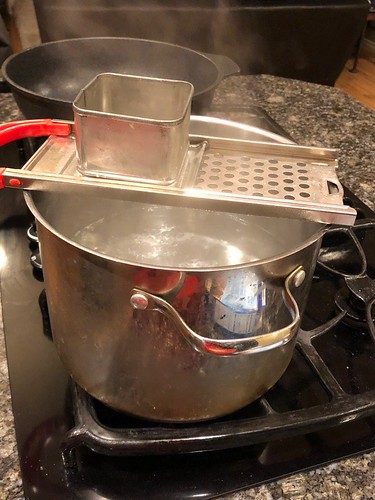
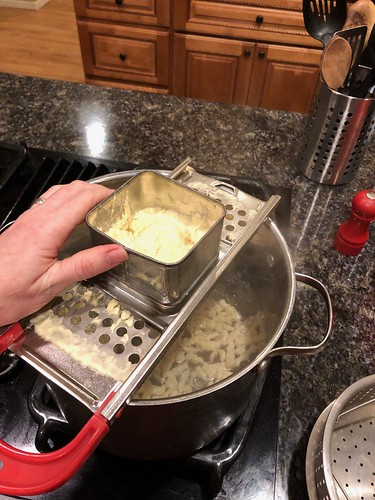
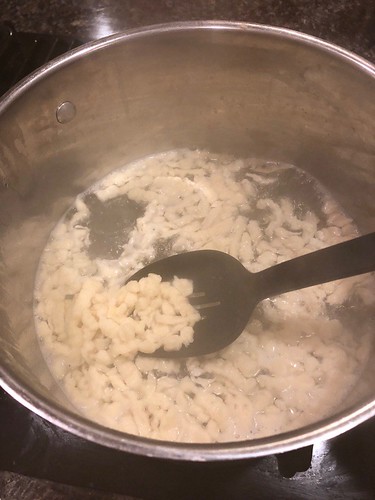
Additional note: Don’t let the dough harden onto the Spätzle maker or your pasta pan—clean right away with hot water and soap.
As soon as the sausages are done, use the rapid release. Remove the sausages, reserving the liquid.
The next step might be a little surprising—break out your wok (or, a large saute pan). Bring a small amount of grapeseed oil to medium-high heat. Brown the sausages for 1-2 minutes on each side; set aside.
Reduce heat slightly and add the butter to the wok. Place the Spätzle into the wok to crisp (about 3-4 minutes). Remove the browned Spätzle onto a serving dish. Pour the reserved sauce into the wok and turn to high so that the liquid reduces and thickens (mash up the apple into the sauce—it should blend right in). Adjust the seasoning using vinegar, garlic, salt and pepper, and mustard.
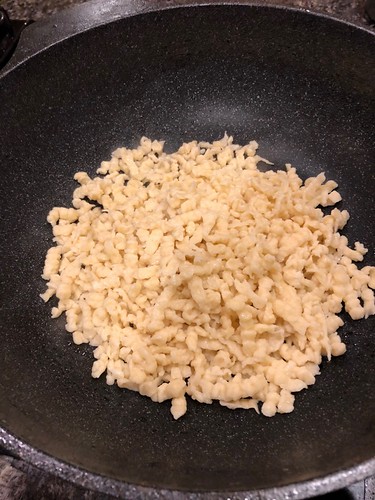
Cut the last apple piece into thin slices.
To serve, place a generous helping of butter-browned Spätzle onto each plate with a sausage (either whole or sliced), pour over some sauce, and garnish with apple slices and parsley.
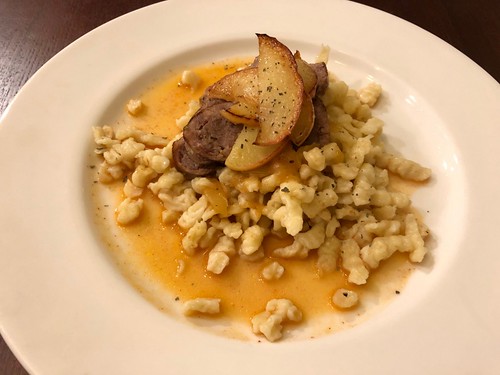
Kristen J. Gough is the Global Cuisines & Kids Editor for Wandering Educators.
Photos courtesy and copyright Kristen J. Gough
This article was originally published in 2018 and updated in 2024.



















